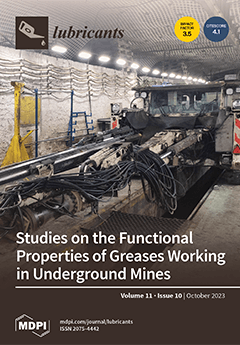Exploring the doping components of the coating is of great significance for improving the tribological properties of the MoS
2-based coating. The optimization of magnetron sputtering process parameters can also improve the coating quality. In this paper, the effects of working gas
[...] Read more.
Exploring the doping components of the coating is of great significance for improving the tribological properties of the MoS
2-based coating. The optimization of magnetron sputtering process parameters can also improve the coating quality. In this paper, the effects of working gas flow rate on the microstructure in a vacuum chamber, nano-hardness, and tribological properties of Ce-Ti/MoS
2 coatings were studied using DC and RF unbalanced co-sputtering technology. It is found that the coating structure was coarse and porous when the Ar flow rate was excessive (70 sccm), significantly affecting the mechanical properties; there are pit defects on the surface of the coating when the flow rate is just minor (30 sccm), and the coating easily falls off during the friction process. When the flow rate is 40~60 sccm, the coating grows uniformly, the hardness reaches 7.85 GPa at 50 sccm, and the wear rate is only 4.42 × 10
−7 mm
3 N
−1 m
−1 at 60 sccm. The coating doped with Ce and Ti is an approximate amorphous structure. Under appropriate gas flow rate conditions, the friction induces a transfer film with a layered structure, and the MoS
2 (002) crystal plane orientation is arranged in parallel at the edge of the wear debris, effectively reducing the shear force during sliding and reducing wear. Based on rare earth doping, this study improves the tribological properties by optimizing the working gas parameters, which plays a reference role in preparing high-quality MoS
2-based coatings.
Full article





